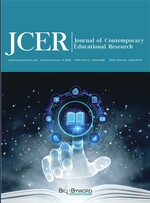Abstract
Classroom silence is complex and discrete problem. It affects the overall teaching and learning quality as well as the high-quality development of both teachers and students. Avoiding classroom silence is a highly dynamic and valuable learning process. This study explores the ecological logic of classroom silence of both teachers and students based on the connotation of classroom silence and deconstructs the endogenous and exogenous mechanisms of classroom silence from the perspectives of escape culture and the continuity theory. Following that, we construct a new model of interaction for elementary school classroom, which includes optimizing the teaching evaluation tools, creating a multidimensional physical technology environment, and fostering an interactive culture of returning to the classroom, so as to promote the overall classroom effectiveness.
References
Pekrun R, Goetz T, Perry RP, et al., 2004, Beyond Test Anxiety: Development and Validation of the Test Emotions Questionnaire (TEQ). Anxiety, Stress & Coping, 17(3): 287–316. http://doi.org/10.1080/10615800412331303847
Harley JM, Pekrun R, Taxer JL, et al., 2019, Emotion Regulation in Achievement Situations: An Integrated Model. Educational Psychologist, 54(2): 106–126. http://doi.org/10.1080/00461520.2019.1587297
Dewaele JM, Witney J, Saito K, et al., 2018, Foreign Language Enjoyment and Anxiety: The Effect of Teacher and Learner Variables. Language Teaching Research, 22(6): 676–697. http://doi.org/10.1177/1362168817692161
Pekrun R, 2006, The Control-Value Theory of Achievement Emotions: Assumptions, Corollaries, and Implications for Educational Research and Practice. Educational Psychology Review, 18(4): 315–341. https://doi.org/10.1007/s10648-006-9029-9
Yu Z, 2016, The Analysis About the Factors of Silence in College English Classroom. Studies in Literature and Language, 12(5): 105–110. http://doi.org/10.3968/8402
Liu M, 2005, Reticence in Oral English Language Classrooms: A Case Study in China. TESL Reporter, 38(1): 1–16.
Bottalico P, Astolfi A, Hunter EJ, 2017, Teachers’ Voicing and Silence Periods During Continuous Speech in Classrooms with Different Reverberation Times. The Journal of the Acoustical Society of America, 141(1): 26–31. http://doi.org/10.1121/1.4973312
Frenzel AC, Daniels L, Buric I, 2021, Teacher Emotions in the Classroom and Their Implications for Students. Educational Psychologist, 56(4): 250–264. https://doi.org/10.1080/00461520.2021.1985501
TJakobsson P, Stiernstedt F, 2018, Voice, Silence and Social Class on Television. European Journal of Communication, 33(5): 522–539. http://doi.org/10.1177/0267323118784819
Savage G, 2008, Silencing the Everyday Experiences of Youth? Deconstructing Issues of Subjectivity and Popular/Corporate Culture in the English Classroom. Discourse: Studies in the Cultural Politics of Education, 29(1): 51–68. http://doi.org/10.1080/01596300701801344
Gregersen T, 2007, Breaking the Code of Silence: A Study of Teachers’ Nonverbal Decoding Accuracy of Foreign Language Anxiety. Language Teaching Research, 11(2): 209–221. http://doi.org/10.1177/1362168807074607
Li BD, 2011, Theory of Teaching and Learning, People’s Education Press, Beijing, 2.
Hayes R, Matusov E, 2005, Designing for Dialogue in Place of Teacher Talk and Student Silence. Culture & Psychology, 11(3): 339–357. http://doi.org/10.1177/1354067x05055525
Ollin R, 2008, Silent Pedagogy and Rethinking Classroom Practice: Structuring Teaching Through Silence Rather than Talk. Cambridge Journal of Education, 38(2): 265–280. http://doi.org/10.1080/03057640802063528
Thiel U, 2011, The Early Modern Subject: Self-Consciousness and Personal Identity from Descartes to Hume, Oxford University Press, NewYork, 103.
Sedova K, Navratilova J, 2020, Silent Students and the Patterns of Their Participation in Classroom Talk. Journal of the Learning Sciences, 29(4–5): 681–716. http://doi.org/10.1080/10508406.2020.1794878
Gabb D, 2006, Transcultural Dynamics in the Classroom. Journal of Studies in International Education, 10(4): 357–368. http://doi.org/10.1177/1028315306288594
Wu CN, 1999, The Sociology of Classroom Teaching, Nanjing Normal University Press, Nanjing, 117.
Velez JJ, Cano J, 2008, The Relationship Between Teacher Immediacy and Student Motivation. Journal of Agricultural Education, 49(3): 76–86. http://doi.org/10.5032/jae.2008.03076
Waldeck J, Kearney P, Plax T, 2001, Teacher E-Mail Message Strategies and Students’ Willingness to Communicate Online. Journal of Applied Communication Research, 29(1): 54–70. http://doi.org/10.1080/00909880128099
